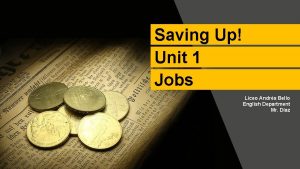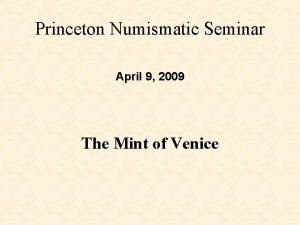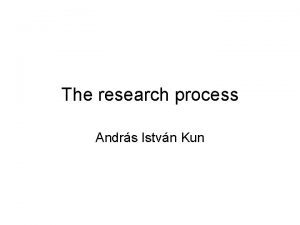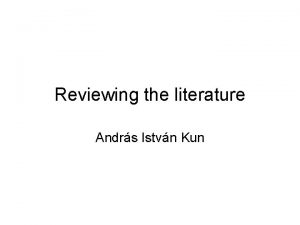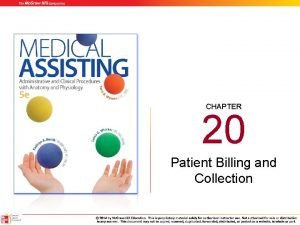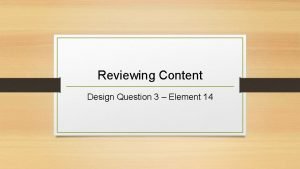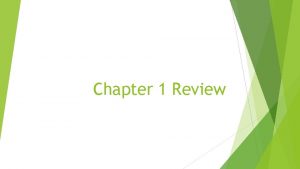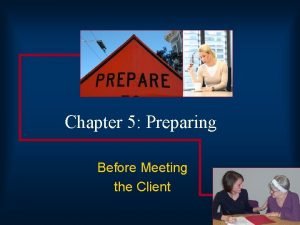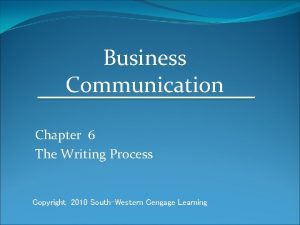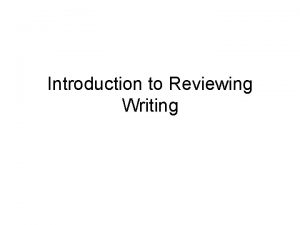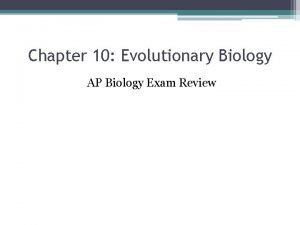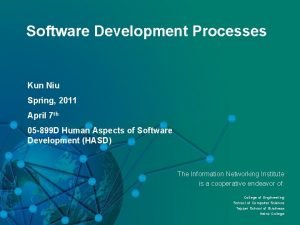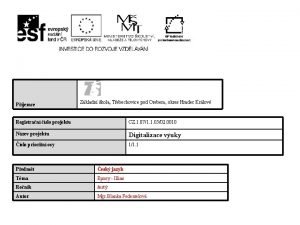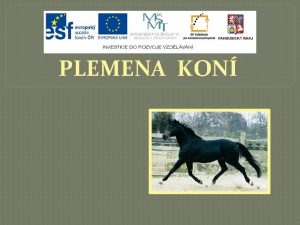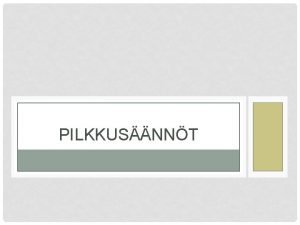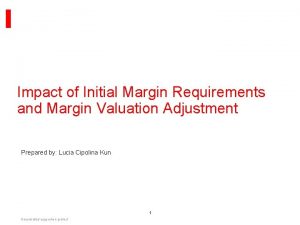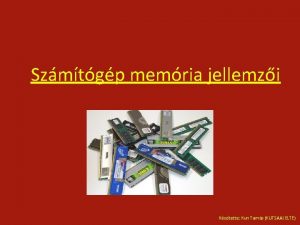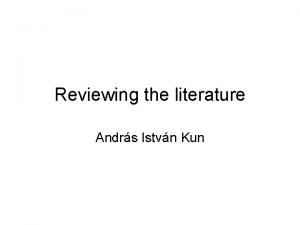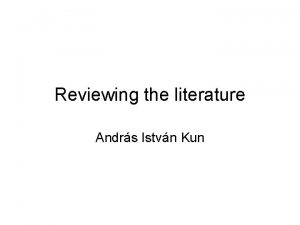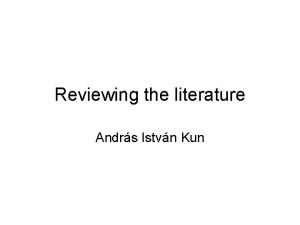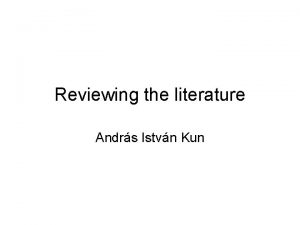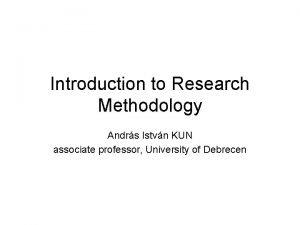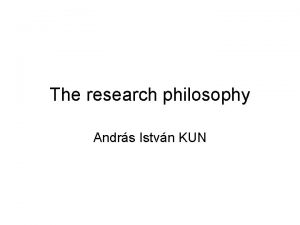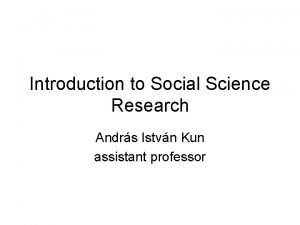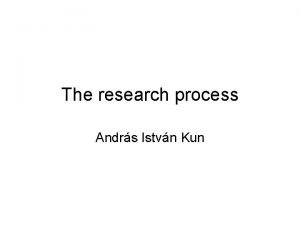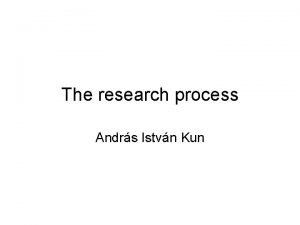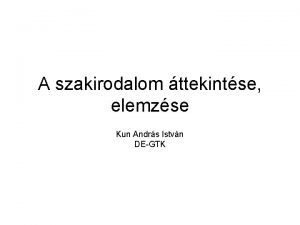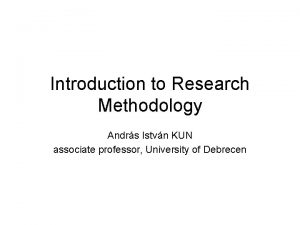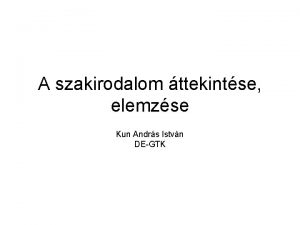Reviewing the literature Andrs Istvn Kun Cyclic neverending










































- Slides: 42

Reviewing the literature András István Kun

Cyclic (‘never-ending’) process of research Concepts theory Data analysis Inductive Deductive Research question Empirical data Where is the place of literature reviewing?

From problem to findings The role of literature • Broad research problem – Could be found with the help of literature • Research topic – White spots, suggestions by articles, thinking further previous results, repeating previous studies with modifications… • Research questions – The connection to literature should be expressed • Hypotheses – Regularly are based on literature review • Methodology – What is acceptable and/or useful, how to perform • Examination and results – Literature could be the source of data; how to report results • Discussion and conclusion – A help in understanding the results; findings should be linked back to the literature

Functions of reviewing literature • Knowledge basis • Theoretical background • Help to find a research problem: – What is known and what is unknown – How can you contribute to the existing knowledge body of your profession – Finding the appropriate hyptheses (abduction) • Help to find out what methodology to use – Formal hypotheses, research techniqe, sampling… • Enables you to contextualize your findings

Paradox of literature review • You read to know, but • You have to know what to read (and you have to have some knowledge to understand) • Solution: iterative process of research reviewing

The progress of reviewing the literature (Saunders et al. 2016)

Improving methodology • What are the accepted methodologies • Methodological problems and solutions • An empirical/methodological review should be part of a literature review chapter of theses or dissertations

Knowledge basis • To some extent it is needed to show the context of your research and your findings • Obligatory chapter for Bachelor, Master and Ph. D theses

5 steps of reviewing literature 1. Search for existing literature in your of study; 2. Review the literature selected; 3. Develop a theoretical framework; 4. Develop a conceptual framework; 5. Writing up the literature review.

Types of critical review • Integrative review: critiques and synthesises to generate new framework and perspectives • Historcal • Theoretical • Methodological • Other systematic

Adopting a critical perspective • Previewing: what is the precise purpose of the text? • Annotating: ’dialogue’ • Summarising • Comparing and contrasting

A good review… 1. From general to specific (research questions). 2. Summarizing the main topics, ideas. Include the key theories within your topic area. Demonstrate that your knowledge is up-to-date. 3. Summarise, compare and contrast 4. Narrow down to the research work that is more relevant to your own research 5. Provide a detailed account of the main findings of the literature and show they are related. 6. Where and how can we contribute? 7. Guide the reader to the sections where our contributions are explained.

Main sources • • • Books Journals Grey literature Statistical data Online information

Categories of sources (Saunders et al. )

Books • Availability – – Libraries Bookshops Bibliographies (!) Internet: computer catalogs (keywords, subject) • Advantages: greater likelihood of importance, relevance, quality • Disadvantages: not up to date, price, avaliability, quality-control (bibliography!) • They serve best as starters

Journals • Advantages: more up-to-date than books (depends on the journal), area-specific journals • Disadvantages: need more knowledge to be understood • Serve best for focused studies • Availability: – Libraries – Electronic databases (!) – Internet

Gray literature • Grey literature (or gray literature) is a term used variably by the intelligence community, librarians, and medical and research professionals to refer to a body of materials that cannot be found easily through conventional channels such as publishers, "but which is frequently original and usually recent„ – – – Working papers Theses Company documents Magazines etc.

Quality in research • Whowhat can be qualified? – Researcher – Article – Journal – Institution – Publisher –…

Quality in research (Scientometrics) • The most accepted field of qualification is based on journals. • Academic journals • Referred journals • Peer reviewing • Journal qualification systems – – Based on citation (aim: measuring impact) Rankings Impact factors Hirsch index (h-index), half-life, immediacy – „Page rank”, altmetric score…

An example: ABDC journal quality list • http: //www. abdc. edu. au/ • In 2007, ABDC established an ABDC Journal Quality List to overcome the regional and discipline bias of international lists. • Reviewed in 2013 and 2009. The next major review will be in the second half of 2017. • In 2016: interim review: – – 1) new journals started since 1 January 2011; 2) removal of predatory open access journals; 3) change of Field of Research (Fo. R) grouping; and 4) incorrect factual details - to produce a revised 2016 list.

ABDC journal quality list • The ABDC Journal Quality List 2013 comprises 2, 767 different journal titles, divided into four categories of quality, A*: 6. 9%; A: 20. 8%; B: 28. 4%; and C: 43. 9% journals. • In each Field of Research (Fo. R) group, journals deemed NOT to reach the quality threshold level are not listed.

The Journal Impact Factor (JIF) (Wo. S, Clarivate Analytics) • From 1975 • The journal must be indexed in the Journal Citation Reports • Calculation: – IF for year X = A / B. – A = citations in year X on the citable articles of the journal fromyears (X-1) and (X-2). – B = total number of the citable articles n a journal in years (X-1) és (X-2). – IF for year X is published in year (X+1). • The sum of the IFs can be used as a quality measure of authors, too.

Highest JIF journals by some areas (in 2015) • Economics: JOURNAL OF ECONOMIC LITERATURE, IF: 6. 614 • General management: ACADEMY OF MANAGEMENT REVIEW, IF: 7. 288 • Accounting, finance: JOURNAL OF FINANCE, IF: 5. 290 JOURNAL OF ACCOUNTING & ECONOMICS, IF: 3. 535 • Logistics: TRANSPORTATION RESEARCH PART B: METHODOLOGICAL, IF: 3. 769 SUPPLY CHAIN MANAGEMENT - AN INTERNATIONAL JOURNAL, IF: 2. 731 • http: //www. lib. unideb. hu/hu/adatbazis? b=i • > Impact Factor Social Sciences Edition



SCImago Journal Rank (SJR, Scopus, Elsevier) • A competitor of Wo. S, JIT • It is free: http: //www. scimagojr. com • Q 1 -Q 4 quartiles


Hirsch index or h-index • Measuring the most important publications • Author level • h: an author has published h papers each of which has citations in at least h papers Wikipedia

Where to start your search • You can search for: – Title – Author – Keyword – JEL classification – In text: abstract or full

Where to start your search • Electronic databases: – lib. unideb. hu (meta search engines) – www. jstor. org – search. epnet. com (EBSCO database) – http: //www. nber. com/ – http: //econpapers. repec. org/ • University pages • Pages of libraries • Library…

Where to start your search • „Social media” for researchers: – academia. edu – researchaget. net – ssrn. com – scholar. google. hu – tudoster. idea. unideb. hu/en






„Publish or Perish” • You are a good researcher if you can prove it through qualified publications. • The role of citations. • Its adverse effects. • The journey of a manuscript to become an article.

Co-authors • Reasons: – – Working together on the given paper, Partners in the same research team, Provide a significant help (data, money, their name and contacts…) Other reasons • Order of the co-authors: – Role – Name • The number and the position of the co-authors can be considered when evaluating a researcher

The journey of a paper to be published • • Writing Selecting the journal: submission Editorial review Peer review (decision: refuse, major correction, minor correction, without correction) – Open review – Single blind review – Double blind review • • Editorial decision on acceptance Editing, grammatical corrections on-line first publication „Real” publication (with volume & issue numbers)

Two current trends • Open Access movement • Predatory journals

Referencing • Why? The role of references in research. • When? • How? Systems of referencing. – Author-date sytems: Harvard, APA – Numeric systems: in the text or in the list • Plagiarism

Thanks for your attention
 Andrs bello
Andrs bello Andrs mint
Andrs mint Istvn
Istvn Istvn
Istvn Reviewing the literature
Reviewing the literature The process of classifying and reviewing past due accounts
The process of classifying and reviewing past due accounts Section 4 the minor parties
Section 4 the minor parties Reviewing key terms
Reviewing key terms Section 4 flatworms mollusks and annelids
Section 4 flatworms mollusks and annelids Reviewing content
Reviewing content Reviewing concepts and vocabulary chapter 1
Reviewing concepts and vocabulary chapter 1 Structure and function of mitochondria
Structure and function of mitochondria Reviewing key terms
Reviewing key terms Preparatory empathy examples
Preparatory empathy examples What is writing process in business communication
What is writing process in business communication What is reviewing
What is reviewing Reviewing key concepts reproductive barriers
Reviewing key concepts reproductive barriers Cooperative business definition
Cooperative business definition Vi har kun en sol tekst
Vi har kun en sol tekst Epos o dobývání troje
Epos o dobývání troje Americký klusák
Americký klusák Franz marc modrý kůň
Franz marc modrý kůň The pet girl of sakurasou mc
The pet girl of sakurasou mc Pilkutus
Pilkutus Emma kadler
Emma kadler Batu bersurat yang dijumpai di sdok kok thom
Batu bersurat yang dijumpai di sdok kok thom Xva mva system
Xva mva system Kyokushin karate dojo kun
Kyokushin karate dojo kun Pul clovek napul kun
Pul clovek napul kun Kmija
Kmija Kun tamás
Kun tamás Ajiniyoz romani
Ajiniyoz romani Cái miệng nó xinh thế
Cái miệng nó xinh thế Các châu lục và đại dương trên thế giới
Các châu lục và đại dương trên thế giới Bổ thể
Bổ thể Từ ngữ thể hiện lòng nhân hậu
Từ ngữ thể hiện lòng nhân hậu Tư thế ngồi viết
Tư thế ngồi viết Thứ tự các dấu thăng giáng ở hóa biểu
Thứ tự các dấu thăng giáng ở hóa biểu Thơ thất ngôn tứ tuyệt đường luật
Thơ thất ngôn tứ tuyệt đường luật Chúa yêu trần thế
Chúa yêu trần thế Sự nuôi và dạy con của hươu
Sự nuôi và dạy con của hươu Diễn thế sinh thái là
Diễn thế sinh thái là đại từ thay thế
đại từ thay thế
